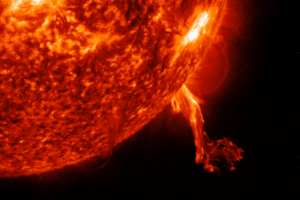The change is caused by the beginning of a new solar cycle.

At the end of 2021, the operators of the cluster of Swarm satellites of the European Space Agencies (ESA) have noticed something strange: devices that measure the Earth's magnetic field have begun to plunge into the atmosphere at incredibly high speeds up to 10 times faster than before. These changes coincided with the beginning of a new solar cycle, and experts fear that the next few years will be very difficult for spacecraft, according to Space.com.
“Over the past five or six years, satellites have sunk about two and a half kilometers a year. But since December last year, they have been practically diving. The dive speed from December to April is 20 kilometers per year, “said Anya Stromme, head of the Swarm mission.
Read also: A powerful” long-playing “flash was recorded on the Sun
Satellites orbiting Earth are always faced with the resistance of the atmosphere, which slows down the spacecraft and causes it to fall back to the planet. Usually satellites do not experience re-entry into the atmosphere and burn up in it. This resistance of the atmosphere forces the dispatchers of the International Space Station to perform regular maneuvers to keep the orbit of the station at 400 km above the Earth.
Scientists know that the intensity of such resistance depends on solar activity – the amount of solar wind coming from the Sun. , which varies depending on the phase of the solar cycle. The last cycle, which ended in December 2019, was quite calm, with fewer sunspots than usual and a long minimum of activity.
But last fall, the star began to wake up, emitting more solar wind and generating more spots, flashes and emissions of coronal mass. And the upper atmosphere of the Earth is already feeling the effects of this.
“In the upper atmosphere, where it interacts with the solar wind, there is a lot of complex physics that we still do not fully understand. We know that this interaction causes the atmosphere to rise. This means that denser air is shifted to higher altitudes, “said Stromme.
Dense air means higher resistance for satellites. Despite the fact that the density is still incredibly low at an altitude of about 400 kilometers above the Earth, its increase is enough to actually cause some satellites in low orbits to fall.
“It's almost like running away from the wind . It's harder, it's more resistance – that's why satellites slow down, and when they slow down, they sink, “Stromme added.
The Swarm group, launched in 2013, consists of three satellites, two of which orbit the Earth at an altitude of 430 kilometers, about 30 kilometers above the ISS. The third satellite Swarm orbits the planet a little higher – at an altitude of about 515 km above the ground. According to Stromm, two low-orbit spacecraft were more affected by the Sun than a higher satellite.
The situation with the lower two became so dangerous that by May, operators had to start lifting satellites with onboard engines to save them. .
The Swarm group is not the only one to have suffered from worsening sunny weather. SpaceX lost 40 Starlink satellites, which were hit by a magnetic storm immediately after launch. During such storms, the satellites fall into lower orbits. The lower the orbit of the satellite when the storm starts, the higher the risk that the satellite will not be able to recover.
Starlink satellites are in orbit about 550 kilometers, which is much higher than the danger zone, but immediately after launch they are much lower, at an altitude of about 350 kilometers above the Earth, and then rise. SpaceX believes that this approach has advantages, because if a satellite is defective, it will quickly burn up in the atmosphere, rather than turn into a new piece of space debris. But in deteriorating space weather, such satellites will be vulnerable to new flares.
According to Stromme, all satellites in orbit within 400 kilometers will be threatened. This also applies to the ISS. Coincidentally, the height of the new space revolution has fallen to a minimum of solar activity, with most satellites experiencing their first solar maximum. More importantly, the Sun is now behaving more aggressively than predicted by the models, with large sunspots, coronal mass emissions and solar winds hitting our planet.
At the same time, some experts see positive aspects in this. They believe that the increase in solar activity will help clear the Earth's orbit of space debris.
Recall, April 25, the Sun had a double flare . It led to a short-term disconnection of radio communications over Asia and Australia.




